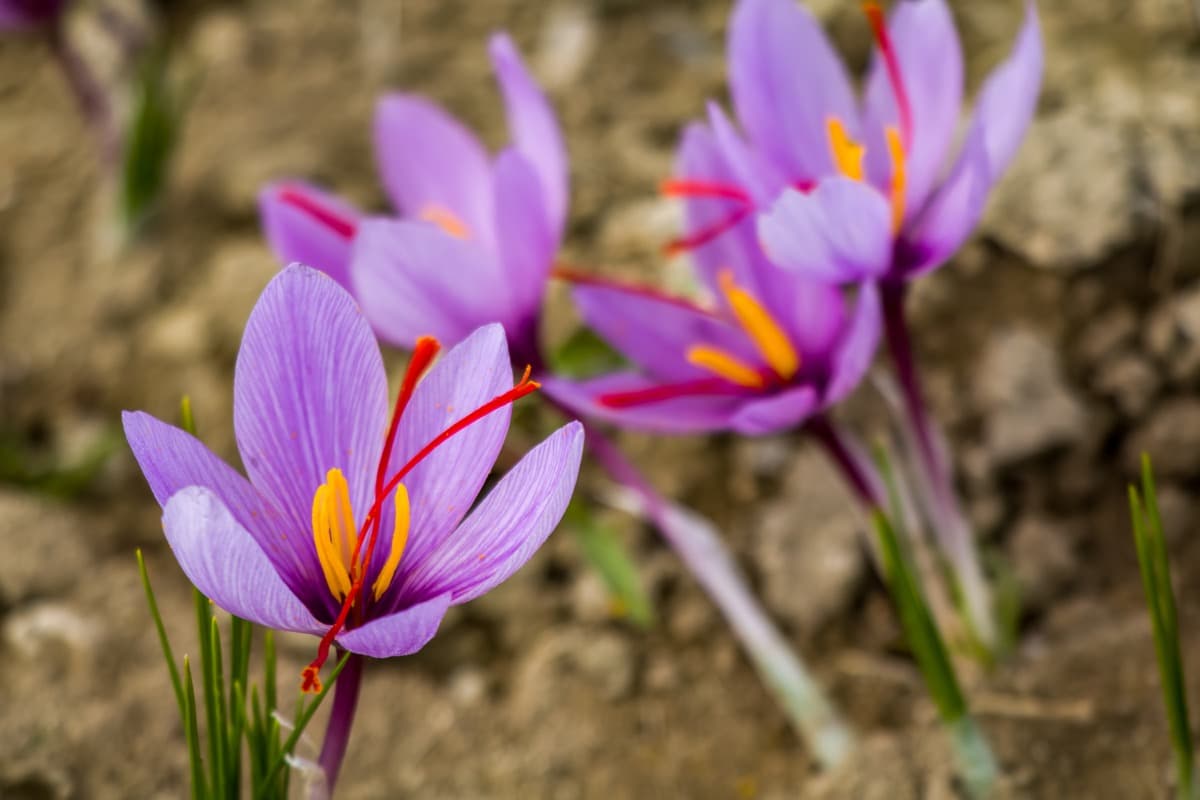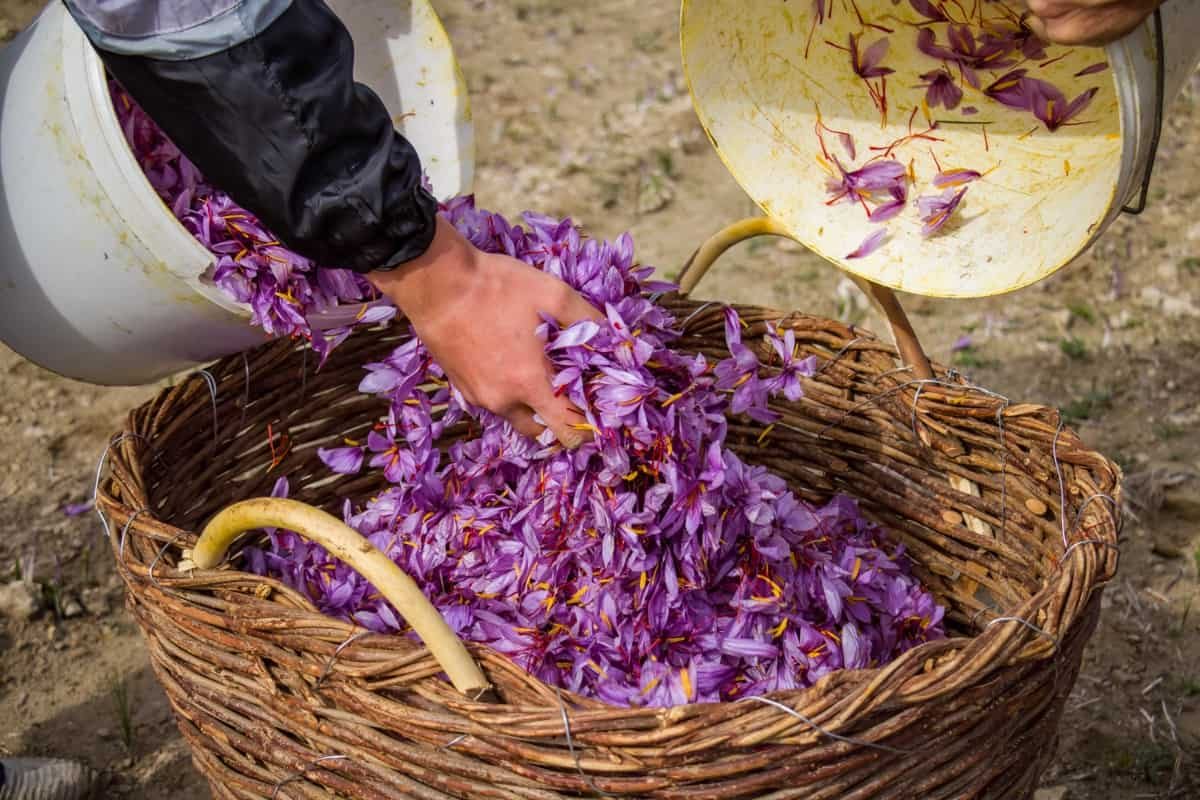Saffron farming, known as “red gold,” is a lucrative, high-value crop with increasing demand worldwide. This cost and profit analysis provides an overview of the economics of establishing a saffron farm on a one-acre land. The project report explores the initial investment, recurring expenses, potential yield, market prices, and profitability, helping entrepreneurs and farmers make informed decisions about saffron cultivation.

What is Saffron Farming?
Saffron, scientifically known as Crocus sativus, is a perennial plant that originated in Iran centuries ago and has since spread across the Mediterranean and East Asia. This cultivated perennial blooms in autumn, showcasing beautiful purple flowers accompanied by grass-like leaves and yellow stamens. Harvested by hand, the plant’s three vibrant orange, red, or purple stigmas are carefully dried to produce the valuable spice known as Saffron.
Market and Demand for Saffron Farming
The saffron market witnessed significant growth, with a value of USD 374.6 million in 2020, and is projected to grow at a CAGR of 8.5% from 2020 to 2028. Furthermore, between 2023 and 2028, the market is 8%. The market expansion can be attributed to increasing commercial spaces, growing health consciousness, and Saffron’s medicine utilization.
Despite the substantial effort and land required for cultivation, global saffron production exceeds 200 metric tons annually, with imports surpassing $231 million in 2021. Saffron finds applications across various industries, including food, medicine, cosmetics, perfumery, and textile dying, leading to increased demand in recent years.
Best High-Yielding Variety for Saffron Farming
Kashmiri Saffron: Cultivated in the fertile soils of Kashmir, India, it boasts the darkest red strands with maroon and purple hues. The two grades of Kashmiri saffron, Mongra, and Lacha, differ in quality. Mongra strands are highly regarded for their superior flavor, aroma, and color.
Aquila Saffron: Originally from Iran, it is now grown in the Aquila Province of Italy. The saffron threads are shorter than Kashmiri saffron and exhibit a deep red color without purple undertones. The soil in Aquila is loose and loamy, with sufficient rainfall.
Spanish Saffron: Grown in Spain, the saffron stigmas range from red to orange. It has a milder aroma, requiring a slightly higher quantity for flavoring than Mongra Kashmiri saffron or Aquila saffron. Different varieties of Spanish Saffron include Negin, Sargol, Pushal, Dokhtar Pich, and Root.
Best Package and Practices for Saffron Farming
Climate for Saffron Cultivation: Saffron thrives in sunken and dry regions with elevations ranging from 1500 to 2500 meters above sea level. It requires a 12-hour photoperiod, which influences flowering. While intense heat and dryness are needed in summer, extreme cold in winter is also beneficial.
The Season for Saffron Farming In India, saffron corms are typically planted between June and July, with some areas planted in August and September. Flowering begins in October, marking the harvest season.
Soil for Saffron Farming: Saffron prefers loamy, sandy, and calcareous soils, with gravelly soil being ideal. Heavy clayey soil is unsuitable for saffron cultivation. Soil with a pH of 5.7 to 8.5 is best for optimal growth.
Water Requirement: Saffron has lower water requirements compared to other spices. The soil should be slightly moist but not excessively wet. Weekly irrigation is recommended, with approximately 283 cubic meters of water per acre delivered during cultivation.
Planting Material for Saffron: Farming Saffron cultivation involves using corms, which are compressed underground stems. In India, three main varieties of Saffron are cultivated, particularly in Kashmir: Aquila Saffron, Creme Saffron, and Lacha Saffron.
Land Preparation for Saffron: Cultivation in India Before plowing or planting saffron seeds, thorough plowing should make the soil brittle. Applying 20 tonnes of cow dung, nitrogen, phosphorus, and potassium, is recommended per hectare to ensure soil fertility and vigor of the saffron crop.
Planting: 12-15 cm depth of Saffron Plant Pits is dug with a spacing of approximately 10 cm between plants. Saffron corms are then planted directly into the trenches, and the soil is loosely applied on the surface to allow for adequate air circulation.
In case you missed it: How to Increase Female Flowers in Saffron: Explained in 10 Steps for More Yields and Profit

Time of Planting of Saffron Crop: Saffron corms should be planted appropriately to ensure optimal yield. July and August, particularly mid-July, are best for saffron planting. Planting corms at the recommended depth with proper spacing promotes healthy growth and abundant pollen production.
Irrigation for Saffron Crop: If there is light rain within a few days after planting, there is no need for additional watering. However, irrigation may be required two or three times over 15 days without rain. Proper drainage is crucial to prevent waterlogging and potential crop damage.
Saffron Harvesting and Drying: Saffron harvesting is a meticulous process contributing to its high value. Flowers start blooming approximately three to four months after planting. Harvesting should be done early, between sunrise and 10 AM. The harvested stigma strands are dried under the sun for about five to six days before being packed in airtight containers. Solar dryers can also be used, requiring around 7-8 hours of drying.
Project Report of 1-Acre Saffron Farming
The components included in the cost of cultivation for Saffron farming typically consist of seeds, land preparation, fertilizers, organic manure/compost, irrigation, weed management, pest and disease control, harvesting and threshing, post-harvest management, and miscellaneous expenses.
| Component | Cost (USD) |
| Land preparation | $10 |
| Saffron corms | $40 |
| Fertilizers and manure | $20 |
| Irrigation | $10 |
| Labor (planting, weeding, harvesting) | $25 |
| Pest and disease control | $15 |
| Miscellaneous expenses | $15 |
| Total | $135 |
Total Returns and Net from 1Acre Saffron Farming
- Total Yield: 5 kgs Price per kg of Saffron: $1050
- Total Returns: Total Yield = 5 kgs Price per kg = $1050
- Total Returns = Total Yield x Price per kg Total Returns = 5 kgs x $1050 = $5250
- Cost of Cultivation: $135
- Net Profit: Net Profit = Total Returns – Cost of Cultivation
- Net Profit = $5250 – $135 = $5115
Therefore, the total returns from 1-acre saffron farming would be $5250, and the net profit after deducting the cost of cultivation ($135) would be $5115.
Challenges and Risks in Saffron Farming
Saffron farming poses several challenges and risks. These include the high initial investment and labor-intensive cultivation process, susceptibility to diseases and pests, unpredictable weather conditions affecting yield, market fluctuations, and the risk of counterfeit Saffron. Additionally, maintaining the quality and reputation of Saffron amidst competition is crucial for sustained profitability.
In case you missed it: Frequently Asked Questions About Saffron Farming

Conclusion
Saffron farming on a one-acre land presents a promising economic opportunity. Despite the initial investment and challenges, the increasing demand for Saffron and its high market value can lead to substantial profits. However, careful planning, proper management, and market awareness are essential for maximizing profitability in saffron cultivation.
- Feed Your Flock for Less: Top 10 Tips to Save on Chicken Feed
- Ultimate Guide to Ossabaw Island Hog: Breeding, Raising, Diet, and Care
- Hatching Answers: The Top 10 Reasons Your Chickens Aren’t Laying Eggs
- Eggs and Economics: Breaking Down the Cost of Raising Backyard Chickens
- Defend Your Greens: Proven Methods to Keep Iguanas Out of Your Garden
- Ultimate Guide to Cinnamon Queen Chicken: A Comprehensive Guide for Beginners
- Ultimate Guide to California Tan Chicken: Breeding, Raising, Diet, Egg-Production and Care
- Ultimate Guide to Marsh Daisy Chicken: Breeding, Raising, Diet, and Care
- 10 Types of Chicken Farming Businesses You Can Start for Profits